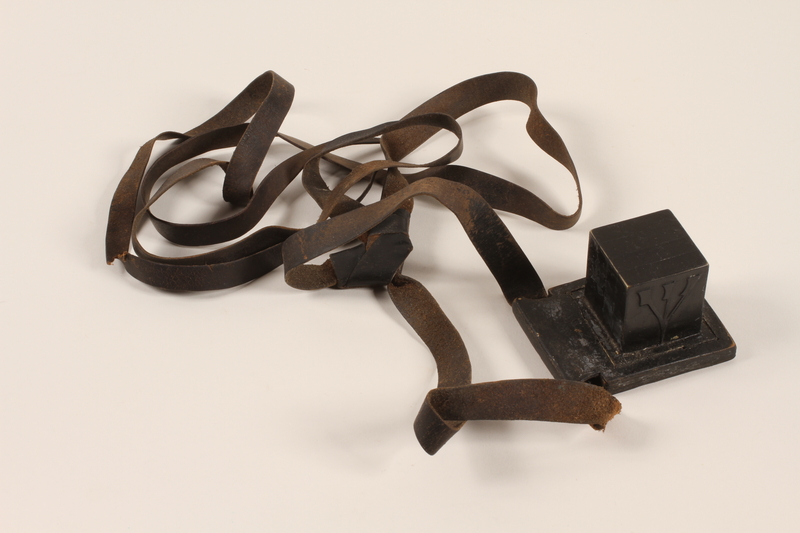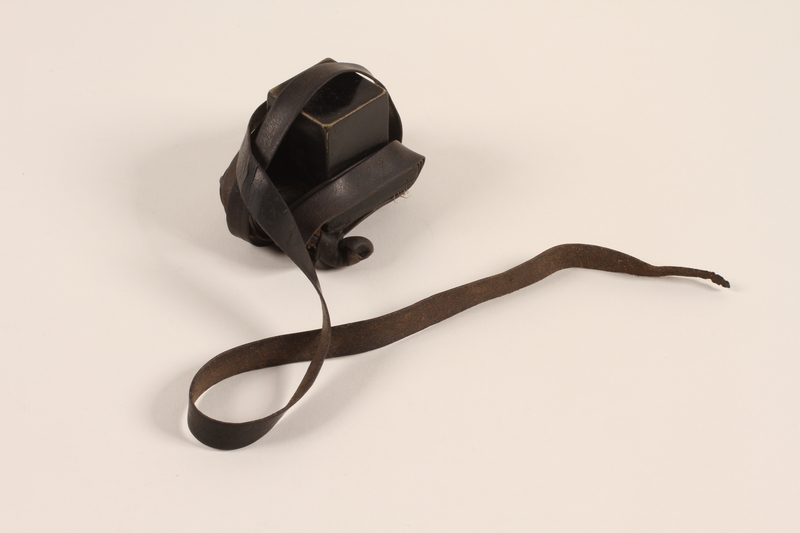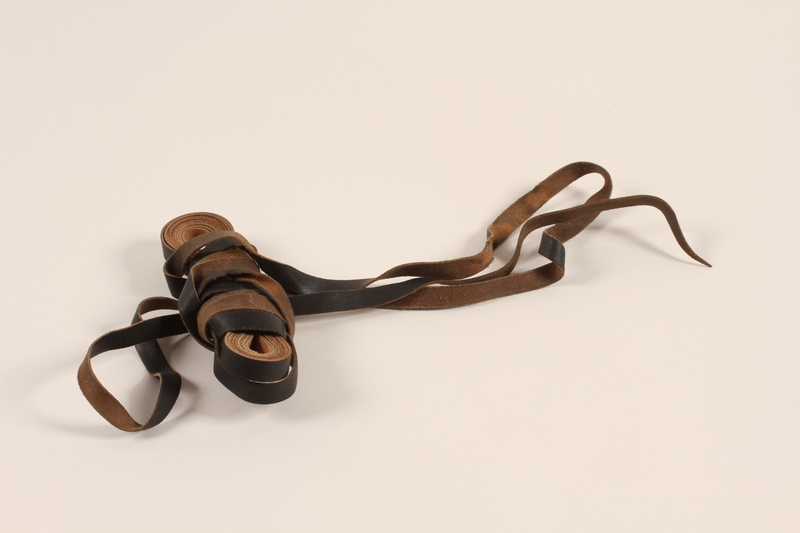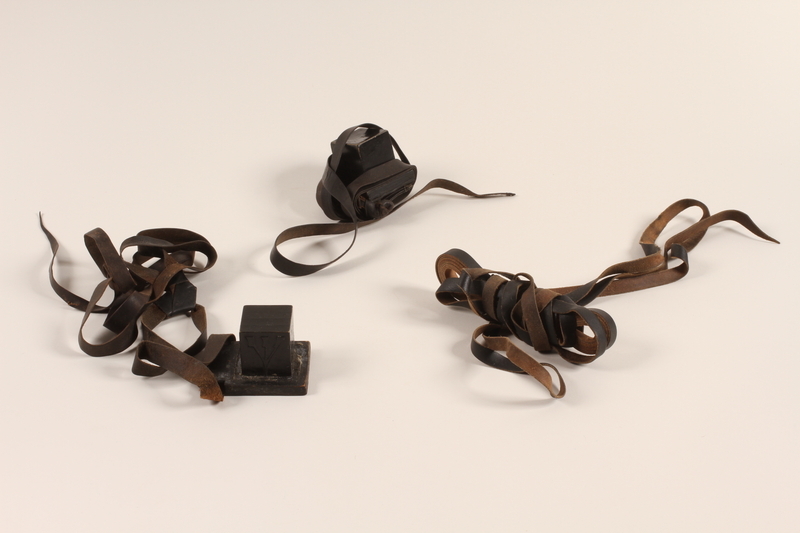Overview
- Brief Narrative
- Head and hand tefillin with an extra leather strap used by Samuel Eckstein, who immigrated to the United States from Ratno, Russia (Ratne, Ukraine) in 1908, and settled in Colorado. Tefillin are small boxes that contain prayers that are attached to leather straps and worn by Orthodox Jewish males during morning prayers. Samuel was joined in 1912 by his wife, Edna (Yetta) Kwasznik Eckstein, with their young son.
- Date
-
emigration:
1908
- Geography
-
use:
Denver (Colo.)
- Credit Line
- United States Holocaust Memorial Museum Collection, Gift of Samuel Veta
- Markings
- a. left and right side, right side with four strokes : ש
- Contributor
-
Subject:
Samuel Eckstein
- Biography
-
Shlomo (Samuel) Eckstein was born about January 15, 1878, in Ratno, Russia (Ratne, Ukraine) to a Jewish family. He married Yetta (Yitke) Kwasznik on June 15, 1906. Yetta was born approximately June 26, 1885, in Ratno to a Jewish family. She had a younger brother Motel, born in 1888. A son, Edmund (Edward), was born in the fall of 1907. The next year, Samuel immigrated to the United States, sailing from Hamburg, Germany, and arriving in New York on May 25, 1908. He settled in Denver, Colorado. Yetta and Edmund joined him there in 1921. Yetta began to use the name Edna. Samuel was a laborer and eventually a driver with the Teamsters union. The couple had four more children: Rebecca, (April 16, 1913- September 12, 1971), Annie born 1915, Isadore, born 1918, and Abraham, born 1922. Rebecca (Betty) married Leo Veta and they adopted an infant girl and, in 1950, an infant boy, whom they named Samuel. Samuel’s biological mother, Ruth Haneman, had fled Nazi Germany with her family for Shanghai, China. Both her parents died in Shanghai in 1943, leaving sixteen year old Ruth responsible for her younger siblings. Samuel, age 68, died on March 9, 1946. Edna, age 92, died on January 12, 1977.
Physical Details
- Language
- Hebrew
- Classification
-
Jewish Art and Symbolism
- Category
-
Jewish ceremonial objects
- Object Type
-
Tefillin (lcsh)
- Physical Description
- a. Head tefillin, a square, black painted, sewn leather box or batim constructed of four leather strips centered on a square, four-layered platform sewn together with gut from kosher animals. The left and right sides of the box have an embossed Hebrew Shin letter; the right Shin has four strokes. The platform has a triangular, notched side with an opening through which a black painted, knotted strap is threaded. The bottom of the strap is unfinished. The box should contain four parchment scrolls inscribed with a Torah verse. Measurements represent batim height and width, with the strap length recorded as depth.
b. Hand tefillin, a square, black painted, leather box or batim centered on a square, four-layered leather platform that is sewn together with gut from kosher animals. The platform has a triangular, notched side with an opening through which a black painted, knotted strap is threaded. The bottom of the strap is unfinished. The box should contain a parchment scroll inscribed with four Torah verses. The strap is wrapped around the box and platform for storage.
c. Black painted, leather strap tightly coiled with reverse calf on the bottom. - Dimensions
- a: Height: 2.125 inches (5.398 cm) | Width: 2.500 inches (6.35 cm) | Depth: 42.625 inches (108.268 cm)
b: Height: 2.875 inches (7.302 cm) | Width: 3.125 inches (7.938 cm) | Depth: 4.625 inches (11.747 cm)
c: Height: 2.625 inches (6.668 cm) | Width: 6.625 inches (16.827 cm) | Depth: 3.000 inches (7.62 cm) - Materials
- a : leather, paint, gut, parchment
b : leather, paint, gut, parchment
c : leather
Rights & Restrictions
- Conditions on Access
- No restrictions on access
- Conditions on Use
- No restrictions on use
Keywords & Subjects
Administrative Notes
- Legal Status
- Permanent Collection
- Provenance
- The tefillin set was donated to the United States Holocaust Memorial Museum in 2012 by Samuel Veta, the son of Ruth Haneman and the grandson of Edna and Samuel Eckstein.
- Record last modified:
- 2022-08-02 16:28:25
- This page:
- https://collections.ushmm.org/search/catalog/irn47029
Download & Licensing
In-Person Research
- By Appointment
- Request 21 Days in Advance of Visit
- Plan a Research Visit
- Request to See This Object
Contact Us
Also in Ruth Haneman and Edna Eckstein family collection
The collection consists of documents, correspondence, and photographs relating to the experiences of Ruth Haneman and her family, who fled Nazi Germany for Shanghai and, after the war, emigrated to the United States, and of artifacts, correspondence, and photographs relating to the experiences of Edna Kwasznik and Samuel Eckstein in Russia and then the United States during the early 20th century.
Date: approximately 1906-1958

Eckstein and Haneman family papers
Document
Collection of photographs, documents, and correspondence relating to the Haneman family from Berlin, who immigrated to Shanghai in 1939; Ruth Haneman was the donor's biological mother. Among the documents are Japanese visas; registration documentation; passports; and a death announcement for Charlotte Hanemen from the "Shanghai Jewish Chronicle," dated September 10, 1944. The collection also includes material concerning the Echstein (donor's) maternal adoptive family, which immigrated to the United States from Ratno, Poland; includes photographs; letters; and a Ketubah between Yutta Itka Kwasznik and Shlomo Samuel Eckstein (donor's adoptive grandparents), signed in Ratno, Poland on June 15, 1906.
Infant’s embroidered quilt and duvet cover made by a Jewish immigrant
Object
Small red quilt enclosed in a white duvet made by Edna (Yetta) Kwasznik Eckstein, who immigrated to the United States with her young son from Ratno, Russia (Ratne, Ukraine) in 1912. They joined her husband, Sam, who had left Ratno in 1908 and settled in Denver, Colorado. The quilt is embroidered Good Luck Baby and may have been brought with her, but it is likely that it was made in the US.
Cross stitched table runner with Russian motto made by a Jewish immigrant
Object
Table runner with a cross stitched floral design and inscription made by Edna (Yetta) Kwasznik Eckstein, who immigrated to the United States with her young son from Ratno, Russia (Ratne, Ukraine) in 1912. They joined her husband, Sam, who had left Ratno in 1908 and settled in Denver, Colorado. The table runner, embroidered with her American name and a proverb in old fashioned Carpatho-Rusyn, may have been brought with her, but it is likely that it was made in the US.
Table runner with cross stitch bird and flowers made by a Jewish immigrant
Object
Table runner with a cross stitched bird design and floral border made by Edna (Yetta) Kwasznik Eckstein, who immigrated with her young son from Ratno, Russia (Ratne, Ukraine) in 1912. They joined her husband, Sam, who had left Ratno in 1908 and settled in Denver, Colorado. The table runner, and a similar companion runner, 2012.72.3, may have been brought with her, but it is likely that it was made in the US.
Pillow sham with embroidered animals made by a Jewish immigrant
Object
Large, square pillow sham top cover with a red, embroidered design made by Edna (Yetta) Kwasznik Eckstein, who immigrated to the United States with her young son from Ratno, Russia (Ratne, Ukraine) in 1912. They joined her husband, Sam, who had left Ratno in 1908 and settled in Denver, Colorado. The pillow sham, one of a set of four, may have been brought with her.
Pillow sham with embroidered animals made by a Jewish immigrant
Object
Large, square pillow sham top cover with a red, embroidered design made by Edna (Yetta) Kwasznik Eckstein, who immigrated to the United States with her young son from Ratno, Russia (Ratne, Ukraine) in 1912. They joined her husband, Sam, who had left Ratno in 1908 and settled in Denver, Colorado. The pillow sham, one of a set of four, may have been brought with her.
Pillow sham with embroidered animals made by a Jewish immigrant
Object
Large, square pillow sham top cover with a red, embroidered design made by Edna (Yetta) Kwasznik Eckstein, who immigrated to the United States with her young son from Ratno, Russia (Ratne, Ukraine) in 1912. They joined her husband, Sam, who had left Ratno in 1908 and settled in Denver, Colorado. The pillow sham, one of a set of four, may have been brought with her.
Pillow sham with embroidered animals made by a Jewish immigrant
Object
Large, square pillow sham top cover with a red, embroidered design made by Edna (Yetta) Kwasznik Eckstein, who immigrated to the United States with her young son from Ratno, Russia (Ratne, Ukraine) in 1912. They joined her husband, Sam, who had left Ratno in 1908 and settled in Denver, Colorado. The pillow sham, one of a set of four, may have been brought with her.
Embroidered black velvet tefillin pouch owned by a Jewish immigrant
Object
Black velvet tefillin bag with a cross stitched design and Hebrew text used by Samuel Eckstein, who immigrated to the United States from Ratno, Russia (Ratne, Ukraine) in 1908, and settled in Colorado. Tefillin are small boxes that contain prayers that are attached to leather straps and worn by Orthodox Jewish males during morning prayers. Samuel was joined in 1912 by his wife, Edna (Yetta) Kwasznik Eckstein, and their young son.
Embroidered brown velvet tallit pouch used by a Jewish immigrant
Object
Brown velvet tallit pouch with an embroidered Star of David and Hebrew text used by Samuel Eckstein, who immigrated to the United States from Ratno, Russia (Ratne, Ukraine) in 1908, and settled in Colorado. Tallit are prayer shawls worn by Jewish males durng services. Samuel was joined in 1912 by his wife, Edna (Yetta) Kwasznik Eckstein, and their young son.
Book
Object
Book
Object
Book
Object
Book
Object
Prayer book issued for Jewish soldiers in the US Army. The contents cover: Sabbath services. Daily services. High Holy Day services. Festival services. Prayers for special occasions.







